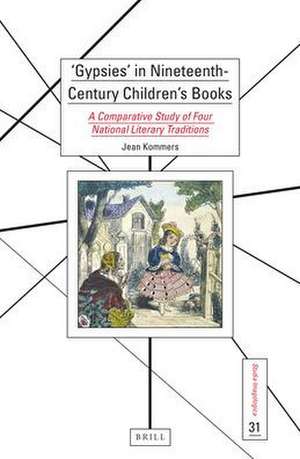'Gypsies' in Nineteenth-Century Children’s Books: A Comparative Study of Four National Literary Traditions: Studia Imagologica, cartea 31
Autor Jean Kommersen Limba Engleză Hardback – 31 aug 2022
Preț: 654.24 lei
Preț vechi: 797.85 lei
-18% Nou
Puncte Express: 981
Preț estimativ în valută:
125.20€ • 135.95$ • 105.17£
125.20€ • 135.95$ • 105.17£
Carte indisponibilă temporar
Doresc să fiu notificat când acest titlu va fi disponibil:
Se trimite...
Preluare comenzi: 021 569.72.76
Specificații
ISBN-13: 9789004522800
ISBN-10: 9004522808
Pagini: 350
Dimensiuni: 155 x 235 mm
Greutate: 0 kg
Editura: Brill
Colecția Brill
Seria Studia Imagologica
ISBN-10: 9004522808
Pagini: 350
Dimensiuni: 155 x 235 mm
Greutate: 0 kg
Editura: Brill
Colecția Brill
Seria Studia Imagologica
Notă biografică
Jean Kommers (Radboud University Nijmegen) is an anthropologist, participating in a research project on the history of "Gypsies": Paradojas de la ciudadanía (University of Seville). He specializes in ethnography and image formation about ‘exotic’ peoples. His Ph.D. thesis is about the Dutch Colonial Administration in the former East Indies, 1800-1830, with special attention to the ethnographic knowledge that officials pretended to possess.
Cuprins
List of illustrations
A Book about Tales, Tales That Do Things
Introduction
1 Subject, Sources and Approach
2 Representation and Symbolism: An Analysis Referring toDutch Narratives
1Introduction
2The Beginning: Some Translations
3Stealing Children or Stealing Gypsies?
3.1 Crossing the Border
3.2 Who May Cross the Border?
3.3 The Border
3.4 Differences in Social Status and the ‘Intermediate Period’
3.5 The Character of the Intermediary
3.6 The Temptation
4 Why are Gypsies in Juvenile Literature Thieves of Children?
5 Xenophobia and Compassion
6 Conclusion
3 Intermezzo: How an Enduring German Religious Tale Changed into a ‘gypsy-tale’: Translation and Enculturation of Von Schmid’s Heinrich von Eichenfels (1817)
4 Gypsies in English Juvenile Literature
1 Introduction
2 Gypsies and “Englishness”
2.1 Introduction
3 Early Representations of gypsies (1787–1849)
3.1 Tales from the Late Eighteenth Century
3.2 The Early Nineteenth Century: Illustrated Moral andInstructive Texts
3.3 The Early Nineteenth Century: Literary Tales
4 The Victorian Age
4.1 Some Approaches
4.2 Textual gypsies as Presented in Victorian Children’sLiterature
5 Conclusion
5 German Juvenile gypsy-Literature
1 Introduction
2 Early Nineteenth-Century German gypsy-tales
3 Some Post-1860 Tales
4 Conclusion
6 French Juvenile Literature
1 Introduction
2 Some Pre-1860 Texts
3 After 1860
4 Conclusion
7 Concluding Observations
1 Some Initial Reflections
2 Some Thoughts on Contemporary Interpretation
3 Analysis and Evaluation/Interpretation of Texts (andAuthors)
4 A Literary Approach: Some Recurrent Themes
5 The Literary Traditions
Bibliography
Index
A Book about Tales, Tales That Do Things
Introduction
1 Subject, Sources and Approach
2 Representation and Symbolism: An Analysis Referring toDutch Narratives
1Introduction
2The Beginning: Some Translations
3Stealing Children or Stealing Gypsies?
3.1 Crossing the Border
3.2 Who May Cross the Border?
3.3 The Border
3.4 Differences in Social Status and the ‘Intermediate Period’
3.5 The Character of the Intermediary
3.6 The Temptation
4 Why are Gypsies in Juvenile Literature Thieves of Children?
5 Xenophobia and Compassion
6 Conclusion
3 Intermezzo: How an Enduring German Religious Tale Changed into a ‘gypsy-tale’: Translation and Enculturation of Von Schmid’s Heinrich von Eichenfels (1817)
4 Gypsies in English Juvenile Literature
1 Introduction
2 Gypsies and “Englishness”
2.1 Introduction
3 Early Representations of gypsies (1787–1849)
3.1 Tales from the Late Eighteenth Century
3.2 The Early Nineteenth Century: Illustrated Moral andInstructive Texts
3.3 The Early Nineteenth Century: Literary Tales
4 The Victorian Age
4.1 Some Approaches
4.2 Textual gypsies as Presented in Victorian Children’sLiterature
5 Conclusion
5 German Juvenile gypsy-Literature
1 Introduction
2 Early Nineteenth-Century German gypsy-tales
3 Some Post-1860 Tales
4 Conclusion
6 French Juvenile Literature
1 Introduction
2 Some Pre-1860 Texts
3 After 1860
4 Conclusion
7 Concluding Observations
1 Some Initial Reflections
2 Some Thoughts on Contemporary Interpretation
3 Analysis and Evaluation/Interpretation of Texts (andAuthors)
4 A Literary Approach: Some Recurrent Themes
5 The Literary Traditions
Bibliography
Index












